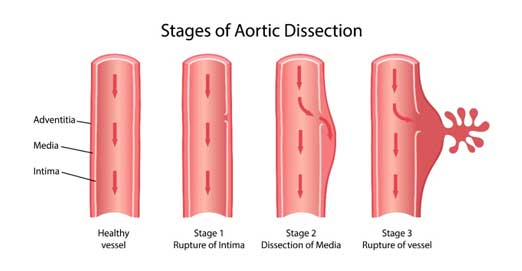The aorta is a major cane-shaped artery that branches off the left lower chamber of the heart. The purpose of the aorta is to carry oxygenated blood away from the heart to the major organs of the body: the brain, lungs, kidneys, abdomen, and lower extremities. An aortic dissection occurs when a tear develops in the inner layer (lining) of the aorta, causing the blood to fill the middle layer, and further filling and extending the tear, thereby separating the aorta. According to Dr. Wiesenfarth, “Aortic dissection is the most common catastrophe of the aorta, 2-3 times more common than rupture of the abdominal aorta. When left untreated, about 33% of patients die within the first 24 hours, and 50% die within 48 hours. The 2-week mortality rate approaches 75% in undiagnosed patients (p.1). It can be caused by high blood pressure, aneurysms, plaque build up in the arteries (atherosclerosis), connective tissues diseases such as Marfan syndrome, family genetics, and traumatic injuries from a major car accident or from a high fall. For this article and blog, which only focuses on personal injuries, I will focus on aortic dissection caused by a motor vehicle accident or a high fall.
Aortic dissection is a major medical emergency:
If anyone exhibits these signs or symptoms, please call 911 immediately. Symptoms may include acute chest pain. People may complain of sharp, stabbing, ripping, or tearing pain. The pain can occur below or behind the sternum (breastbone) and radiates to the back or underneath the shoulder blades. The pain can often change locations and radiate to the neck, arms, jaw, abdomen, and hips. People may show the following signs: pale (Caucasians) or ashy/blue/grey (Africa-Americans or Latinos) skin complexion, weak or rapid pulse, shortness of breath, difficulty breathing while lying flat, increased anxiety, fainting, increased dizziness, and heavy sweating. All of these signs are related to the decrease in blood flow to the rest of the body.
The prognosis depends on the timeliness of the diagnosis in the ER, the size of the dissection, and the possibility of a ruptured aorta. If the aorta has not ruptured, the dissection can be managed with surgery and medication to lower the blood pressure. Survivors will be on blood pressure medications for the rest of their life and will require constant follow-up with a cardiologist to monitor the size of the aorta and blood pressure medications.
Unfortunately, an aorta rupture may result in death.

Figure 1: Stages of Aortic Dissection
References
Bolbot, O. (2020). [Illustration]. Stages of aortic dissection: rupture Intima, dissection Media, rupture vessel. Image of healthy and damaged aorta.Retrieved from https://www.shutterstock.com/image-vector/stages-aortic-dissection-rupture-intima-media-1576473301.
Cleveland Clinic. (2020). Aortic Dissection. Retrieved from https://www.mayoclinic.org/diseases-conditions/aortic-dissection/symptoms-causes/syc-20369496
Wiesenfarth, J. M. (2018). Retrieved from https://emedicine.medscape.com/article/756835-overview
